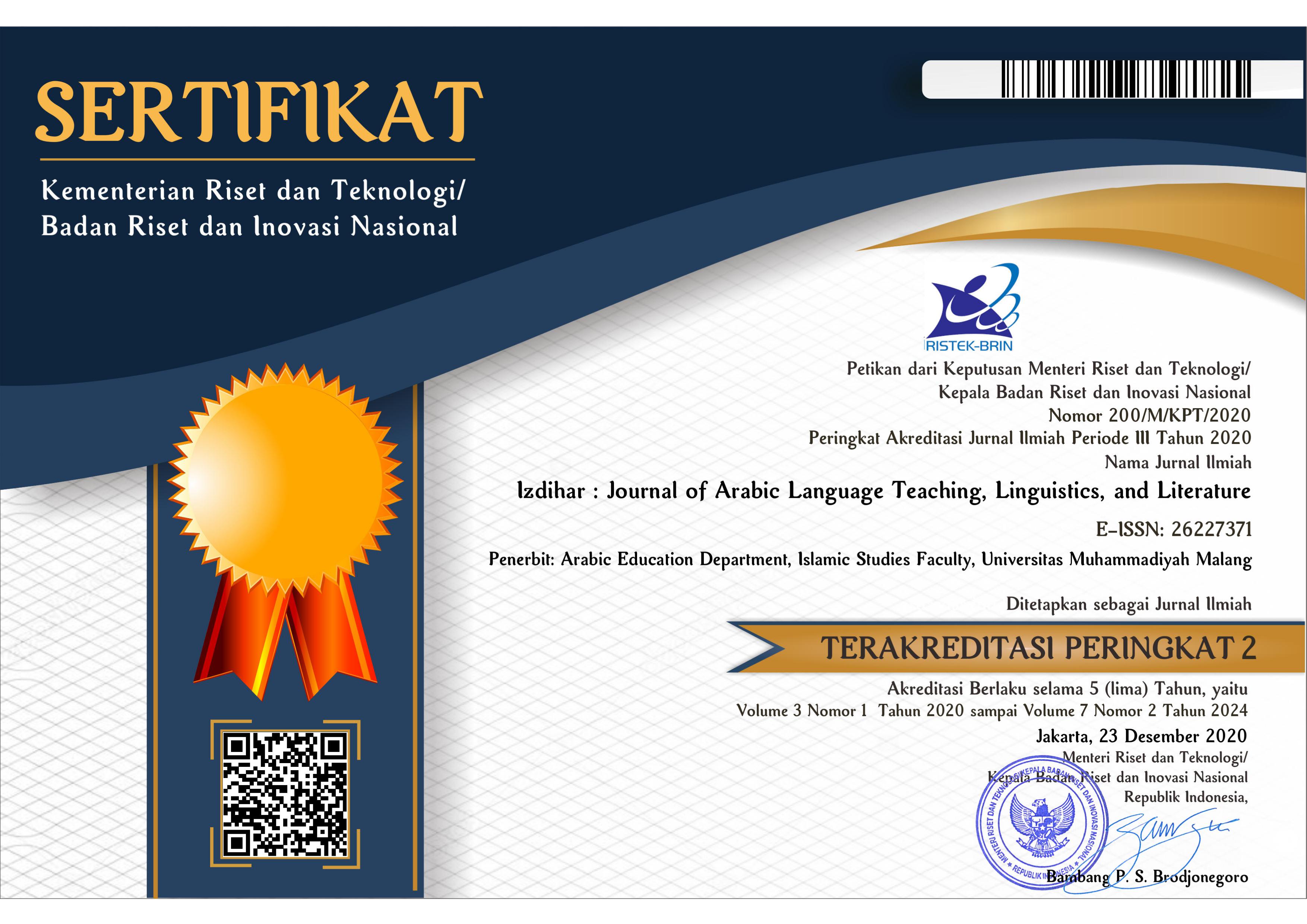The Quality Improvement of Interaction Indicators in Arabic Language Learning for Higher Education
DOI:
https://doi.org/10.22219/jiz.v4i1.15919Keywords:
Arabic Language, Improvement, Indicators, Learning InteractionAbstract
The success of learning Arabic is largely determined by the quality of interaction in learning. This article aims to describe (1) Increasing speaking skills through Arabic learning interactions, (2) Increasing cooperation through learning interactions, and (3) Increasing solidarity through learning interactions. So far, this aspect has been neglected in existing studies. This research approach is qualitative with the type of case study research. The research data were collected through interviews, observation, and documentation. Data analysis starts from data collection to concluding. The results showed that the improvement of speaking skills was carried out by selecting interesting topics, using familiar vocabulary among students, and giving them motivation. In terms of increasing cooperation, this is done by giving joint assignments, joint corrections, making videos, and playing roles. Meanwhile, in the context of increasing solidarity, the activities carried out are by instilling a sense of brotherhood, group work, and giving responsibility to help each other.
Downloads
References
Absatova, M. A., Nishanbaeva, S., Nurpeisova, T. B., & Atemova, K. T. (2018). Experimental study on family formation and moral values of students. journal of intellectual disability - diagnosis and treatment, 6(3). 84-88. DOI: https://doi.org/10.6000/2292-2598.2018.06.03.3
Ahmadi. (2007). Reformulasi kurikulum bahasa Arab madrasah dan perguruan tinggi islam. Himmah, VIII(22), 68–78. Retrieved from http://digilib.iain-palangkaraya.ac.id/id/eprint/1507
Amin, A. (2019). Hubungan kompetensi sosial guru dengan interaksi edukatif dalam perspektif peserta didik. Al-Bidayah, 11(01). 77-106. DOI: https://doi.org/10.14421/al-bidayah.v11i01.175
Andina, E. (2018). Efektivitas pengukuran kompetensi guru. Aspirasi: Jurnal Masalah-Masalah Sosial, 9(2). 204-220. DOI: https://doi.org/10.46807/aspirasi.v9i2.1103
Areva, D., Ansofino, A., & Mona, S. (2014). Pengaruh interaksi pembelajaran dan minat belajar siswa terhadap hasil belajar siswa Kelas VIII pada Mata pelajaran IPS Terpadu di SMP N 2 Lembah Melintang Kabupaten Pasaman Barat. Pendidikan Ekonomi, 1(1). 1-9 Retrieved from https://www.neliti.com/publications/29816/pengaruh-interaksi-pembelajaran-dan-minat-belajar-siswa-terhadap-hasil-belajar-s
Arifin, Z. (2017). The influence of Arabic on Indonesian language. Titian: Jurnal Ilmu Humaniora, 1(1). 77–89. DOI: https://doi.org/10.22437/titian.v1i1.3971
Astuti, D. A., Fauziati, E., & Marmanto, S. (2019). Celebrating students’ diversities through understanding students’ characteristics. International Online Journal of Education and Teaching, 6(4). 723-731. https://iojet.org/index.php/IOJET/%20article/view/653
Bahruddin, Uril. (2017). Musykilah ta’limiyah al-lughah AL-‘arabiyah bi jami’ah maulana Malik Ibrahim Malang wa al-hulul al-muqtarahah laha. LiNGUA: Jurnal Ilmu Bahasa Dan Sastra, 12(1). 26-36 DOI: https://doi.org/10.18860/ling.v12i1.4115
Bahruddin, Uril, Andrian, R., Halomoan, & Mubaraq, Z. (2021). The teaching of maharah qira ’ ah in Arabic for economic management. 58 (2). 9377–9383. https://www.researchgate.net/publication/350286706_The_Teaching_of_Maharah_Qira%27ah_in_Arabic_for_Economic_Management_Department
Bahruddin, Uril, & Halomoan, H. (2019). Tahlîl Al-akhthâ al-syafahiyah al-syâi’ah lada thullâb qism ta’lîm al-lughah Al-‘Arabiyah Fî Al-Jâmi’ah Al-Islâmiyah Al-Hukûmiyah Bi Malang. Arabi : Journal of Arabic Studies, 4(2). DOI: http://dx.doi.org/10.24865/ajas.v4i2.186
Bahruddin, Urıl, & Febriani, S. R. (2020). Student’s perceptions of Arabic online learning during covid-19 emergency. Journal for the Education of Gifted Young Scientists, 8(4), 1483–1492. DOI: https://doi.org/10.17478/jegys.763705
Caruso, V., Mørch, A. I., Thomassen, I., Hartley, M., & Ludlow, B. (2014). Practicing collaboration skills through role-play activities in a 3D virtual world. Lecture Notes in Educational Technology, (9783642382901), 165–184. DOI: https://doi.org/10.1007/978-3-642-38291-8_10
Chen, F., Wang, Y. C., Wang, B., & Kuo, C. C. J. (2020). Graph representation learning: A survey. APSIPA Transactions on Signal and Information Processing, 9(15), 1-21. DOI: https://doi.org/10.1017/ATSIP.2020.13
Dahliani, E. R., Rahmatan, H., & Djufri. (2020). The correlation between students’ interest and learning outcomes in biology. Journal of Physics: Conference Series, 1460(1). DOI: https://doi.org/10.1088/1742-6596/1460/1/012072
Duta, N., Panisoara, G., & Panisoara, I.-O. (2015). The effective communication in teaching. Diagnostic study regarding the academic learning motivation to students. Procedia - Social and Behavioral Sciences, 186, 1007-1012. DOI: https://doi.org/10.1016/j.sbspro.2015.04.064
Febriyanti, C., & Seruni, S. (2015). Peran minat dan interaksi siswa dengan guru dalam meningkatkan hasil belajar matematika. Formatif: Jurnal Ilmiah Pendidikan MIPA, 4(3), 245–254. DOI: https://doi.org/10.30998/formatif.v4i3.161
Filgona, J., Sakiyo, J., Gwany, D. M., & Okoronka, A. U. (2020). Motivation in learning. Asian Journal of Education and Social Studies, 10(4), 16–37. DOI: https://doi.org/10.9734/ajess/2020/v10i430273
Fisman, D. N., Greer, A. L., & Tuite, A. R. (2020). Bidirectional impact of imperfect mask use on reproduction number of COVID-19: A next generation matrix approach. Infectious Disease Modelling, 5, 405-408. DOI: https://doi.org/10.1016/j.idm.2020.06.004
Hidayah, N., Ridwan, N. A., Mahliatussikah, H., Dariyadi, M. W., & Bekhoula, B. (2020). Akuarintar as a media in Arabic teaching and learning for deaf towards sustainable development goals (SDGS) 2030. Izdihar : Journal of Arabic Language Teaching, Linguistics, and Literature, 3(3), 181–196. DOI: https://doi.org/10.22219/jiz.v3i3.13921
John, D. (2017). Employing group work to foster speaking skills : a study of success and failure in the classroom employing group work to foster speaking skills : A study of success and failure in the classroom 1. MEXTESOL Journal, 41(3), 1–9. Retrieved from https://www.mextesol.net/journal/index.php?page=journal&id_article=2521
Maryam Beiki, Neda Gharagozloo, R. R. (2020). The effect of collaborative versus cooperative pre-writing task on writing ability of Iranian EFL learners. Asian EFL Journal Research, 27(3.1), 76–105. DOI: https://doi.org/10.31838/jcr.07.07.114
Ninčević, M., & Vukelić, D.J. (2019). Social and communication competences of students – future teachers. European Journal of Education, 2(3), 47-50. DOI: https://doi.org/10.26417/ejed.v2i3.p47-50
Nugraha, M. (2018). Manajemen kelas dalam meningkatkan proses pembelajaran. Tarbawi: Jurnal Keilmuan Manajemen Pendidikan, 4(01), 27-44. DOI: https://doi.org/10.32678/tarbawi.v4i01.1769
Pérez-López, R., Gurrea-Sarasa, R., Herrando, C., Martín-De Hoyos, M. J., Bordonaba-Juste, V., & Acerete, A. U. (2020). The generation of student engagement as a cognition-affect-behaviour process in a twitter learning experience. Australasian Journal of Educational Technology, 36(3), 132-146. DOI: https://doi.org/10.14742/AJET.5751
Sanah, S., & Hamid, M. A. (2020). Namûdzaj tathwîr mawâd ta’lîm al-lughah al-‘arabiyah fî dhau al-takâmuli baina al-‘ilmi wa al-wahyi. Arabiyat : Jurnal Pendidikan Bahasa Arab Dan Kebahasaaraban, 7(2), 286-304. DOI: https://doi.org/10.15408/a.v7i2.16681
Simarmata, J., Limbong, T., Napitupulu, E., Sriadhi, S., Tambunan, A. R. S., Sinaga, E. K., … Limbong, R. (2018). Learning application of multimedia-based-computer network using computer assisted instruction method. International Journal of Engineering and Technology(UAE), 7(2.13 Special Issue 13). DOI: https://doi.org/10.14419/ijet.v7i2.13.16916
Wachyudi, K., Srisudarso, M., & Miftakh, F. (2015). Analisis pengelolaan dan interaksi kelas dalam pengajaran bahasa Inggris. Jurnal Ilmiah Solusi, 1(4), 40–49. Retrieved from https://journal.unsika.ac.id/index.php/solusi/article/view/67
Wahdah, N., Ainin, M., & Hamid, M.A. (2017). Al-Mu’taqadât nahw ta’allum al-lughah Al-‘arabiyyah bi washfihâ lughah ajnabiyyah ’inda al-muta’allimîn ’abr ikhtilâf al-khalfiyyah al-tsaqâfiyyah. Arabiyat : Jurnal Pendidikan Bahasa Arab Dan Kebahasaaraban, 4(2), 264-281. DOI: https://doi.org/10.15408/a.v4i2.6346
Wargadinata, W. (2020). Mediated Arabic language learning for arabic students of higher education in covid-19 situation. Izdihar : Journal of Arabic Language Teaching, Linguistics, and Literature, 3(1), 59–78. DOI: https://doi.org/10.22219/jiz.v3i1.11862
Zgheib, G. E., & Dabbagh, N. (2020). Social media learning activities (Smla): implications for design. Online Learning Journal, 24(1), 50-66. DOI: https://doi.org/10.24059/olj.v24i1.1967
Downloads
Published
How to Cite
Issue
Section
License
Copyright (c) 2021 Uril Bahruddin, Izdihar : Journal of Arabic Language Teaching, Linguistics, and Literature

This work is licensed under a Creative Commons Attribution-ShareAlike 4.0 International License.
Copyright Notice
Authors who publish with this journal agree to the following terms:
- Authors retain copyright and grant the journal right of first publication with the work simultaneously licensed under a Creative Commons Attribution-ShareAlike 4.0 International License that allows others to share the work with an acknowledgment of the work's authorship and initial publication in this journal.
- Authors are able to enter into separate, additional contractual arrangements for the non-exclusive distribution of the journal's published version of the work (e.g., post it to an institutional repository or publish it in a book), with an acknowledgment of its initial publication in this journal.
- Authors are permitted and encouraged to post their work online (e.g., in institutional repositories or on their website) prior to and during the submission process, as it can lead to productive exchanges, as well as earlier and greater citation of published work (See The Effect of Open Access).
Copyright (c) 2019 Izdihar : Journal of Arabic Language Teaching, Linguistics, and Literature

This work is licensed under a Creative Commons Attribution-ShareAlike 4.0 International License.

















